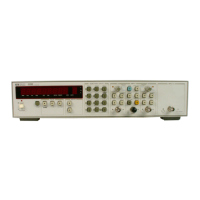8-295. For any failure condition, it is suggested that the power supplies be checked first. The next most impor-
tant signals to check are:
a.
The
4
MHz
'lTL
clock for each of the three microcomputers (at pin 2 of AlU17, U19, and U29).
b. The 10
MHz
oscillator which the Counter uses for its counting reference (at pin 21 of AlU14 and
Urn).
8-2%.
All
troubleshooting requires the following preliminary conditions to be met:
a.
The Counter must
be
connected to the proper line power.
b. The
line fuse must be good.
c.
All
power supply voltages must be correct.
d.
All
printed circuit boards must be correctly installed.
e. The Counter must be clean
and
dry.
f.
The Counter must have been inspected for broken or missing parts.
g.
All
safety precautions must have been observed.
CAUTION
The assemblies and components involved in the following
troubleshooting sections are static sensitive, and should be handled at
a static-free work area, and in accordance with approved procedures.
8-297. Electrostatic Discharge (ESD)
8-298. Electronic components and assemblies
can
be permanently damaged by electrostatic discharge. To avoid
ESD,
use the following precautions:
a. Ensure that static sensitive devices or assemblies are serviced at static-safe work stations providing
proper grounding for service personnel
(e.g., wrist straps).
b. Ensure that static sensitive devices or assemblies are stored in static-shielding containers.
c. DO NOT wear clothing subject to static charge build-up, such as wool or synthetic materials.
d. DO NOT handle components or assemblies in carpeted areas.
e. DO NOT remove the circuit from its conductive foam pad until you are ready to install it.
f.
Avoid touching component leads, handle by the plastic package only.
8-299. Signal Tracing
8-300. This method of troubleshooting uses the conventional techniques of measuring signal levels and observ-
ing waveforms with a multimeter and oscilloscope. Sometimes a known signal is introduced to the suspect circuit
using an external generator, and other times it is the normal operation of the instrument under test that is
studied.
HP
5334B
-
Service
Manual
8-40

